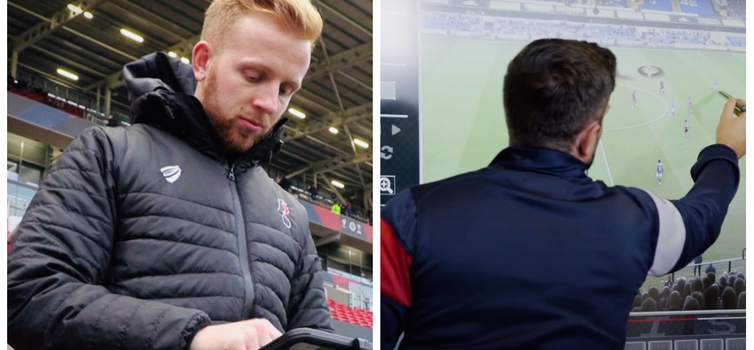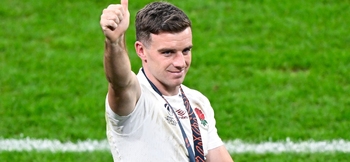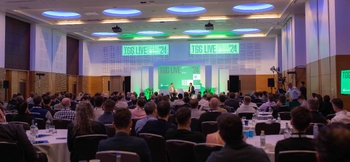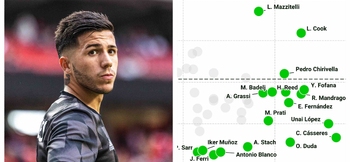Sam Stanton: Building an analysis culture at Bristol City

Sam Stanton (left) was Head of Analysis at Bristol City from 2013 to 2020
Written by Sam Stanton — September 16, 2020
IN the summer of 2013, Bristol City had just been relegated to League One and were rebuilding.
This was when I was brought in by the club from West Brom, where I’d been a Performance Analyst for two years, to become their first Head of Analysis.
The Director of Football, Keith Burt, and the manager, Sean O’Driscoll, wanted me to create, develop and manage a performance analysis department, as well as a means of using analysis to recruit players.
At that time, the club had only one member of analysis staff and no systems, software or equipment in place. Furthermore, the 2013/14 season had already started, so it was a case of ‘building in flight’.
Despite these challenges, we managed to set up a clear analysis structure, as well as processes for training, pre, live and post-match analysis. Sean left two months later and was replaced by Steve Cotterill who, thankfully, was also heavily into analysis.
My aim was to improve the analysis department season-on-season through the use of technology, while continuing to develop buy-in from the players and coaching staff. This was the start of building an analysis culture at the club.
Lee Johnson arrives
Lee arrived as manager in February 2016 and, together, over the course of the next four-and-a-half years, we were able to take the analysis department into a new realm.
I’m proud of what we achieved together, although it wouldn’t have been possible without the help of the staff and players.
An analyst’s job is to be an extension of the manager’s tactical brain and to help him get his style of play and philosophy across to the players.
Along with an ever-growing team of analysts and our senior opposition scout, Luke Coles, I helped the team prepare for matches and also linked Lee’s playing philosophy into the recruitment process.
Working closely with the recruitment team, data analysts and chief scouts, I filtered transfer targets over the short, medium and long term and made sure they were capable of doing what Lee wanted technically, tactically and physically.
As a club, we were innovators and worked on a number of analysis projects that changed the way the team prepared and played.
That’s what this piece is mainly about, so here are seven of those projects:
1. Outdoor screen
We started using the outdoor screen in 2019, but had actually wanted to do it much earlier. Lee had spent time in Germany in 2018 and witnessed how some clubs there were using screens on the training pitch to bring analysis to life.
This really cemented our desire to acquire our own screen to use as a coaching tool and we pushed the decision-makers at the club even harder to get one.
Eventually, we were given the green light to buy an all-weather 12-foot square screen designed bespoke for us by LED Synergy In Andover. I had come across them after speaking to more than 20 different screen companies around the world.

LED Synergy were the best fit for us because they'd worked with hundreds of sports teams on stadium screens. All their screens are made in the UK at their factory and they offer round-the-clock support.
The screen was on a roadworthy trailer, allowing it to be used both at the stadium and training ground and came with mains power and a generator, meaning it could be used all over the training ground, not just close to mains sockets.
We were the first club in the country to have a screen this size for use on our training pitches and once Sky Sports got hold of the news my phone didn't stop ringing! More than 10 Premier League clubs got in contact to ask about the screen and how they could get one too.
It gave us a different way of presenting team meetings and reduced the time the players had to be sat down in meeting rooms for video analysis.
It also gave us the chance to instantly review and feed back video, without losing the flow of a session. On the screen we showed video that had been filmed by the drone (more of that below) which we used at every training session.
The screen allowed us to review details live, so the players understood tactically what we needed from them going into a match. If something wasn’t going in the right direction, we could rectify it there and then.
In summary, the screen allowed us to:
- Give live feedback direct from drone footage.
- Show opposition analysis live during tactical/ shape sessions.
- Present post-match video reviews during training and re-run parts of the matches that needed to be improved as a way of catering for different learning styles.
- Use best-practice video during sessions.
- Show session plans/ live diagrams to aid flow and understanding of the sessions.
- Reduce the time in meeting rooms. This was especially important under the Covid-19 guidelines imposed after March 2020.
2. Drone technology
Throughout Lee’s time at the club we used drone technology to film both first-team and Academy training sessions on a daily basis.
The reason for using drones instead of an IP camera solution or teletowers is because we wanted to be able to change the view of the session easily, as well as film in all weather conditions.
The drones allowed us to take a variety of different vantages - we could go directly above a session, or to the side for a panoramic view, or behind the goal - at the click of a button. Each view allowed us to see different parts of a training session.
Our training pitch was a distance away from the main building, which meant the drone was the easiest solution in the absence of data cabling nearby.
We used the video to monitor and review training sessions and incorporated it into our pre-match preparation. We also used it to monitor training in line with Lee’s tactical periodisation programme.
I know a lot of coaches want to film training, but unless the video is used to analyse and improve individual players or team performance as part of the coaching process it’s a waste of both time and resources.
For me, analysing training is as important as analysing matches. Otherwise, how do you know whether you're fully prepared for a match or not?
Our use of drones was a massive success and, even though Lee and I left the club earlier this year, it's still ingrained in the working practices of both the first team and Academy.
3. Using data to develop players
One of our remits, as both coaches and analysts, was to develop players. I think we can look back and say we did that, because we achieved more than £100m in players sales in our final four years at the club alone.
Having good data analysts is key to this. They create outputs; read and measure the data in line with the club’s philosophy; and highlight potential areas of improvement in both team and individuals.
Data analysts are highly skilled in creating different visuals to help players and staff to easily absorb information. We had two full-time data analysts, fresh from the University of Bath, as well as four performance analysts who had the ability to work with data.
They were all tasked with creating data projects that could show areas in which the team needed to improve and how this could be done. Working closely with Lee and the coaches, we would then work out how to incorporate the learnings into training sessions and his tactical periodisation programme.
These statistical projects could be anything from how to be more effective in the final third to how a particular individual needed to add things to his game in order to improve.
One example would be crossing and final pass decision-making. We used statistical data to show how we could improve our probability of scoring through working the ball into areas in the attacking third.
We also benchmarked players against the league's top-ranked performers on specific metrics in order to show what they needed to do to improve.
Data was used to highlight things the human eye might not have picked up, which could then be worked on in training. For example, a player might be turning down opportunities to play forward when he had a amount of options ahead of the ball, and the data would objectively highlight that.
We also used data to prepare for opponents, creating fixture clustering to pinpoint historic games the opposition had played and how effective they had been against different set-ups.
Having players and staff who were open-minded to data analysis was key. To gain trust, players and coaches often have to be shown how effective data analysis can be in improving them. Everyone wants to improve.
4. Hudl application
We moved to Hudl, the video analysis platform, two seasons ago. This was after we'd trialled different application providers and products.
We settled on Hudl because it integrated into their Sportscode software, which we had used for a while, and because it offered the most features while still being user-friendly.
Hudl provided the club with a central point to share video and information between the analysis staff and coaches/ players. This meant they had video, group chats and schedules available at the click of a button on their phones, laptops or tablets - a million miles from the days when players had to ask to be sent clips after a game or were given a DVD.
Once you’ve developed a clear analysis structure and processes, as outlined above, the use of video can become ingrained in the working week for both players and staff.
5. Video telestration tool
Three seasons ago, after a process of research, I decided that ChyroHego’s Coach Paint could be a great tool to take our analysis to the next level.
The software enables video presentations to be annotated and brought to life, introducing extra tactical detail into video through the use of touch-screen technology. We found it helped the players to take on information more easily.

We could move players on the screen to highlight positions they could have taken up and use the annotation tools to spotlight, zoom and track them.
Coach Paint became a key part of our pre and post-match processes and allowed us to cater for the different learning styles of players and coaches.
We could sync the fitness data from matches to measure distances between units, review team shape and calculate pressing distances in games.
Bringing data and video together is crucial and was a big area of development during my time at the club. Our analysis became more detailed and engaging and Lee could really convey his philosophy of play.
In fact Lee went a step further by having Coach Paint installed at his house, which meant he could prepare meetings and tactical detail before arriving at training the next day.
What an example of the way our analysis culture had grown at the club.
6. Opposition analysis
During my last four years with the club, I developed an opposition analysis application that every player could use. With Apple software, I created a club-bespoke app that had video, written information and statical data on every player in the Championship, as well as any Cup opponents that the team may have come up against.
The application was loaded onto 40 club-owned iPads and given to each squad player. This tool allowed us to cater our analysis to different learning styles to make sure players and coaches were getting the information they needed.
Its use grew from season to season as the analysis culture continued to develop and players wanted more information going into matches to help them prepare for what they would be coming up against.

Stanton and former Bristol City assistant Jamie McAllister
There were clips and written reports on opposition players' strengths and weaknesses and how these might be exploited. The app also had previous line-ups, results and a team video overview for players to watch anytime in order to gain a better understand of how our own team played.
Players are increasingly hungry for information and the app enabled them to be analytical even when they were away from the club, at a time that suited them.
7. Developing analytical coaches
As I've hopefully outlined, analysis has moved away from the old-school view of ‘a geek with a laptop’ to being recognised as a form of coaching in its own right.
Now coaches and managers realise how much it can add to their effectiveness, be it in performance or recruitment. The importance of analysts in today’s game is highlighted by the number of assistants at top clubs who began their careers as analysts: Joao Sacramento at Tottenham, Danny Rohl at Bayern Munich, Kieran McKenna at Manchester United and Joe Carnall at Millwall to name a few.
Soon we will see an analyst becoming a manager of an elite club, I'm sure of that.
During my time at Bristol City, I was keen for the coaches to understand the analysis process and systems. I wanted to move away from it being a one-way process, in which the analyst simply gave coaches and managers their work, to a two-way process in which coaches understood how to be analytical in their work.
The first step was to give coaches the tools they needed for this, including MacBooks and analysis software. Next up was the software and we chose Hudl's Sportscode, because it’s easy to use and very in-depth.
Every coach had Sportscode enabled on their laptops to watch games and create their own clips and movie files, either from training or matches (both pre and post-match). Now they were a part of the analysis process and Lee was among the modern managers, like Pep Guardiola and Mauricio Pochettino, who can use Sportscode.
Across the club we had 35 Sportcode licences for analysts, coaches and players to be able to use.
The three managers I worked with at the club would all watch multiple games, giving me the chance to use what they were seeing and to understand how they saw the game tactically. Suddenly, me and my team of analysts were part of the ‘game plan’.
- Sam Stanton was Head of Analysis at Bristol City from September 2013 to August 2020.




-1.png)





